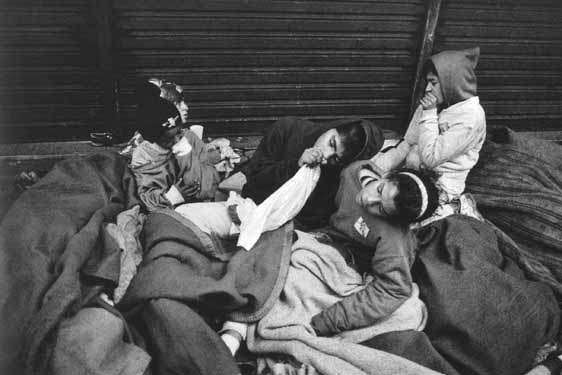 Street children, Sao Paolo, Brazil, 1996 (Sebastiao Salgado)
Street children, Sao Paolo, Brazil, 1996 (Sebastiao Salgado)
 Street children, Sao Paolo, Brazil, 1996 (Sebastiao Salgado)
Street children, Sao Paolo, Brazil, 1996 (Sebastiao Salgado)
The New Pixote
Brazil is a world center of such triumphs as child slavery, with some 7 million children working as slaves and prostitutes, exploited, overworked, deprived of health and education, "or just deprived of their childhood," an International Labor Organization study estimates. The luckier children can look forward to work for drug traffickers in exchange for glue to sniff to "make the hunger go away." The figure worldwide is estimated at hundreds of millions, "one of the grimmer ironies of the age," George Moffett comments. Had the grim result been found in Eastern Europe it would have been a proof of the bestiality of the Communist enemy; since it is the normal situation in Western domains, it is only irony, the result of "endemic third-world poverty...exacerbated as financially strapped governments have cut expenditures for education," all with no cause.
Brazil also wins the prize for torture and murder of street children by the security forces—"a process of extermination of young people" according to the head of the Justice Department in Rio de Janeiro (Helio Saboya), targeting the 7-8 million street children who "beg, steal, or sniff glue" and "for a few glorious moments forget who or where they are" (London Guardian correspondent Jan Rocha). In Rio, a congressional commission identified 15 death squads, most of them made up of police officers and financed by merchants. Bodies of children murdered by death squads are found outside metropolitan areas with their hands tied, showing signs of torture, riddled with bullet holes. Street girls are forced to work as prostitutes. The Legal Medical Institute recorded 427 children murdered in Rio alone in the first ten months of 1991, most by death squads. A Brazilian parliamentary study released in December 1991 reported that 7000 children had been killed in the past four years.
Year 501, Chomsky